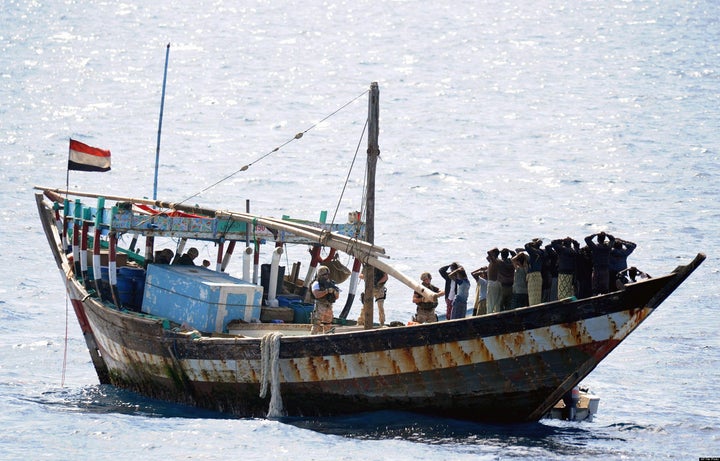
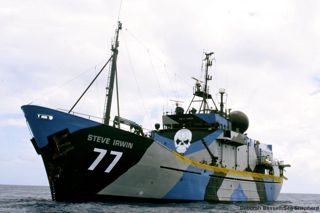 Last week The Sea Shepherd Conservation Society's flagship vessel, the Steve Irwin, was tailed for several miles by three suspicious skiffs with six men in one, five in another and two in the third as the ship and crew transited the Gulf of Aden en route to the Red Sea. The previous day a U.S. military Blackhawk helicopter came in for a bird's eye view of the former British Fisheries patrol vessel which it initially believed to be a Dutch warship. With its fierce new camouflage paint job and the large "77" branded on the bow and flag of the United Nations waving from its forward mast, the same case of mistaken identity that duped the U.S. military may have ultimately helped to keep the pirates at bay in the notorious waters that divide the Somali and Yemen coastlines.
Last week The Sea Shepherd Conservation Society's flagship vessel, the Steve Irwin, was tailed for several miles by three suspicious skiffs with six men in one, five in another and two in the third as the ship and crew transited the Gulf of Aden en route to the Red Sea. The previous day a U.S. military Blackhawk helicopter came in for a bird's eye view of the former British Fisheries patrol vessel which it initially believed to be a Dutch warship. With its fierce new camouflage paint job and the large "77" branded on the bow and flag of the United Nations waving from its forward mast, the same case of mistaken identity that duped the U.S. military may have ultimately helped to keep the pirates at bay in the notorious waters that divide the Somali and Yemen coastlines.
As a Quartermaster aboard the Steve Irwin, I was aware of the potential risks involved on this particular voyage due to the increasingly grim reality and frequency of piracy attacks off the horn of Africa. According to a recent report in The Economist, pirates took 1,181 people hostage off the Somali coast last year alone while about half were released after the payment of ransoms, a few have died of abuse or neglect and around 760 are currently in captivity. Most captives are held prisoner on their own hijacked vessels, some of which are engaged as mother-ships from which further raids are launched.
While the somewhat surreal scene unfolded through my binoculars, the mood on the ship grew more tense by the minute, yet I felt completely confident that our lives were in good hands with Captain Locky Maclean at the helm. A seasoned mariner and veteran navigator of "pirate alley," Maclean remained cool, calm and collected throughout the experience and our 20 person crew of international citizens worked seamlessly to ensure that every measure possible was taken to secure the vessel and keep everyone on board safe and sound.
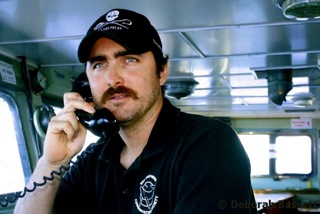 Captain Maclean immediately notified coalition naval authorities of our vessel's coordinate and radioed the adjacent Maersk container ship to warn them of the fast approaching small craft in the area, as merchant ships and oil tankers tend to be the target of choice due to the high ransom they command. Recent reports indicate that ransoms paid last year climbed to $238m, an average of $5.4m per ship, compared with $150,000 in 2005.
Captain Maclean immediately notified coalition naval authorities of our vessel's coordinate and radioed the adjacent Maersk container ship to warn them of the fast approaching small craft in the area, as merchant ships and oil tankers tend to be the target of choice due to the high ransom they command. Recent reports indicate that ransoms paid last year climbed to $238m, an average of $5.4m per ship, compared with $150,000 in 2005.
Eventually the skiffs retreated and both ships successfully entered the Red Sea. Maclean expressed his satisfaction with the way the incident was handled by his crew, many whom were sporting bullet proof Kevlar vests throughout the intense stand off. "Although our crew are volunteers, they are some of the bravest and passionate young people to be found. They were briefed and given the opportunity to disembark prior to the dangerous waters, but all remained and took an active role in preparing the ship's defenses," he stated.
In the week leading up to the crossing of the treacherous passage way that enables 20 percent of the world's commercial shipping, the Sea Shepherd crew -- certainly no strangers to danger on the high seas, gave the Steve Irwin an overhaul that undoubtedly played a critical factor in discouraging the pirates from further pursuit. According to Maclean:
"Most ships carry firearms, however, as Sea Shepherd is a non violent direct action organization, we had to get creative. Possibly the most important measure on board was to put up a convincing initial deterrent. This was achieved by painting the ship camouflage, giving the hull a Navy Patrol look. Furthermore, the entire ship was decorated in barbed wire and 4 foot long steel spikes facing downwards into the sea from the deck level. Finally, I gave the order to maintain vigilant deck watches with water cannons, and immitation weapons at the ready, to make the ship look well crewed and intimidating."
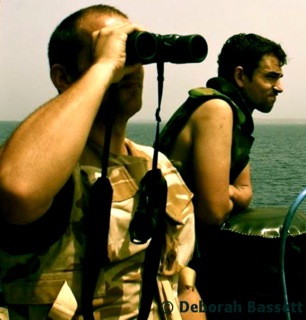
In the event of the worse case scenario -- a ship boarding, several precautionary measures and strategies were in place to further ensure that the ship and crew remained safe and in control of the vessel for as long as possible. Added Maclean:
"We put in place a designated muster area, where the entire crew could remain together, in the event of a boarding. Crew were instructed to close critical parts of the ship in order to give the bridge crew time to put out a MAYDAY and call naval assets in the area. Many areas of the ship were barb wired shut to delay the pirates access to the bridge."
Former French minister and United Nations advisor on piracy, Jack Lang, recently warned the UN Security Council that Somali pirates were becoming the "masters" of the Indian Ocean, costing an estimated $5 billion-7 billion per year. Although patrol ships from over 25 countries monitor the area, prosecuting pirates is an increasingly difficult task due to the costs, rules of engagement and politics. The following excerpt from The Economist helps shed light on the background of the current siuation:
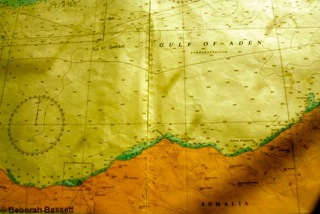
Somali piracy takes the form of hijacking and extortion, rather than conventional robbery at sea. This predatory pattern evolved from "defensive" piracy that began early in the last decade as a response by local fishermen, mainly of the Hawiye clan, to unlicensed foreign trawlers and the dumping of toxic waste. These outsiders exploited the absence of a functioning Somali state capable of protecting its coastal waters. The Hawiye briefly ceased their activities in 2006 when the anti-piracy Union of Islamic Courts occupied their Haradheere stronghold in central Somalia, but the Darod clan, with bases around Bosasso and Caluula on the Gulf of Aden in the semi-autonomous region of Puntland, energetically took up the slack.
The European Union, which operates one of the largest anti-piracy naval forces in the vicinity, states that it is committed to a "comprehensive approach" that combines bringing pirates to justice and helping them find other livelihoods.
The Steve Irwin has recently traversed the Suez Canal and bound for the Mediterranean where the Sea Shepherds, whom ironically are often referred to as "pirates of compassion," will launch their second annual Bluefin Tuna campaign, Operation Blue Rage II, followed by a campaign to combat the annual pilot whale slaughter in the Faroe Islands. For more information please visit: www.seashepherd.org
All Photos: Sea Shepherd/Deborah Bassett